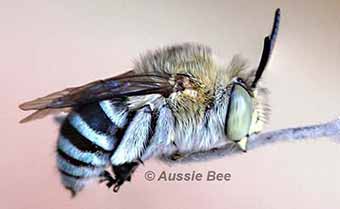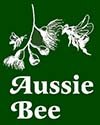IS THAT INSECT A BEE, A WASP OR A FLY?
Aussie Bee > Native Bee Identification Guide > Bees, Wasps or Flies?
Main Features of Bees, Wasps and Flies
Take a look at the following three photos that show typical features of a bee, a wasp and a fly. Then look at our comparison chart, below, for more details.
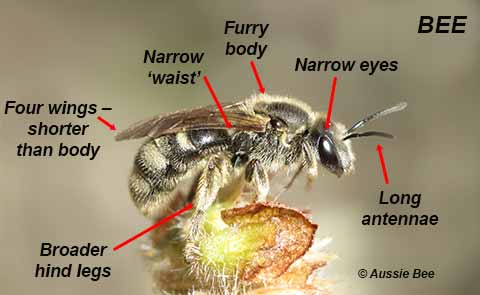
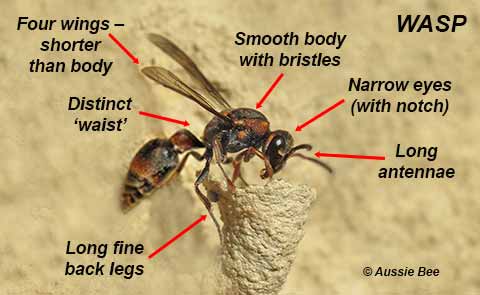
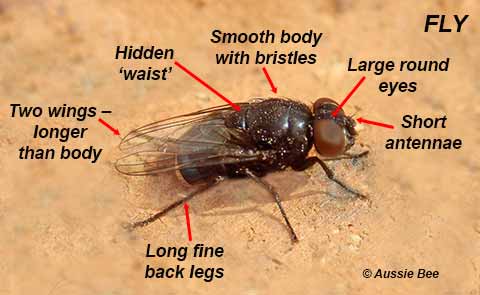
| Bee | Wasp | Fly | |
|---|---|---|---|
| Body shape | Often hourglass shape with short 'waist' | Often slender with distinct 'waist' | Often broad with hidden 'waist' |
| Number of wings | 4 | 2 | |
| Antennae | Long | Short | |
| Eyes | Narrow, on side of head. | Wide and round, toward front of head | |
| Collect pollen? | Yes | No | |
| Furry bodies? | Often furry | Usually shiny, with some bristles | |
| Hind legs | Often with broad segments | Long and fine | |
| More photos | Bee photo gallery | Wasp photo gallery | Fly photo gallery |
More Information
The above table and photos give only typical features of bees, wasps and flies. Remember that there are many thousands of species of these insects and some do not fit into the generalisations given. To confidently distinguish bees, wasps and flies, you need to look at them very closely, and may sometimes need a microscope. Here are some more tips to help you:
Body Shape
Bees, wasps and flies can be generally distinguished by the 'waist' that separates their thorax and their abdomen:
-- Bees have a short narrow waist that gives their body an 'hour-glass' shape.
-- Wasps usually have more pronounced 'waists'. In some the 'waist' is just a distinct narrow area. However others, such as the wasp in the photo above, also have an indented segment at the front of their abdomen. Others have very elongate narrow waists, like a thin straw connecting the thorax and abdomen.
-- Most flies, in comparison, look thick set, because their thorax and abdomen usually fit closely together, hiding the 'waist' area.
Number of Wings
All bees and wasps have four wings, but flies only have two wings. As shown in the following diagrams, two of the wings of flies have been converted into tiny drumstick-shaped structures called Halteres. These structures help flies to perform their acrobatic flying feats.
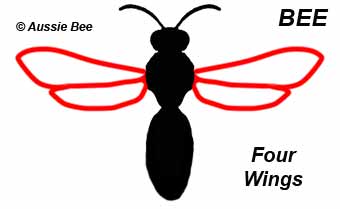
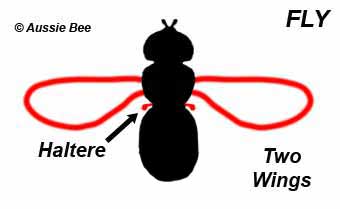
Above: bees have four wings, but flies only have two wings. The back two wings of flies have been converted into club-shaped Halteres, which help flies to balance well during flight.
Wasps and bees usually connect their front and back wings together with tiny hooks when they fly. So you need to look very closely to count the number of wings on your insect. However, if your insect looks like a bee but it only has two wings, then it is definitely a fly.
Eyes and Antennae
Flies have large round eyes that tend to be placed towards the front of the fly's head. In contrast, most bees and wasps have narrow, long, oval eyes on the sides of their heads. Some types of wasps also have distinctive notches in the front edges of their eyes. Bees do not have notches in their eyes.
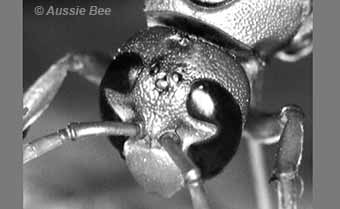
Above: some wasps have a notch in the front margin of each eye.
Pollen-Collecting Hair and the Legs
Female bees collect pollen to feed the young in their nests. To gather the dusty pollen more efficiently from flowers, many bees have thick furry coats. Using a high-powered microscope, we can see that bees have minute feathers on their hairs which help them trap the pollen grains (see photo).
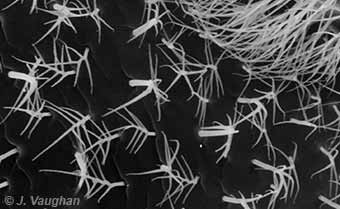
Above: bees have hairs with tiny feathery branches that help them trap pollen when they visit flowers. This Scanning Electron Microscope photograph by John Vaughan shows the hairs on the side of a stingless bee -- with short feathery hair on the lower left and a tuft of long feathery hair on the top right.
Most bees also have special tufts of hair on their hind legs or under their abdomen which help them carry pollen back to their nests. Bright yellow pads of pollen carried on an insect's legs or abdomen are signs of a bee! Furthermore the hind legs of many bees have broad segments to help them carry pollen.
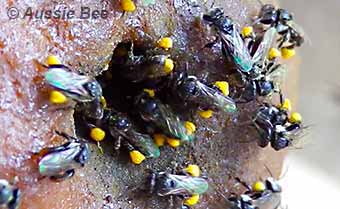
Above: these Tetragonula stingless bees, returning to their nest entrance, are carrying balls of bright yellow pollen on their hind legs.
Wasps in contrast, usually catch insects to feed their young. As they do not collect pollen, very few wasps have hairy coats. Instead most have smooth bodies and they have strong bristles without branches, rather than the fine feathery hairs that bees have. Their hind legs are also long and fine, lacking the special structures that bees have for carrying pollen.
Similarly flies do not collect pollen for their young. So they too usually have smooth bodies, with simple bristles, and long fine legs.
To complicate matters, two major groups of Australian native bees, the Hylaeine bees (Masked Bees) and the Euryglossine bees, do not carry their pollen using body hair. Instead they swallow the pollen that they collect. As a result, these two groups of bees have shiny bodies with very little hair. Their hind legs are also relatively fine. Unfortunately this can make these types of bees look rather like wasps. However, a microscope reveals that even these bees have at least a few feathery hairs, often behind the head or at the back of the thorax.
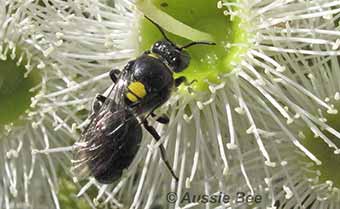
Above: this Masked Bee will swallow the pollen she collects from this flower. Her smooth and shiny body is similar to the body of a wasp.
Although there are some exceptions, one of the easiest ways to recognise a bee is to see if she is carrying pollen back to her nest.
Like to Know More?
For more tips on distinguishing bees, wasps, flies and other wild pollinating insects, download the ID guide compiled by Wild Pollinator Count.
Other Aussie Bee Reports on Identifying Flower Visitors:
-- Native Bee ID Guide
-- Native Bee Photo Gallery
-- Wasp Photo Gallery
-- Fly Photo Gallery

